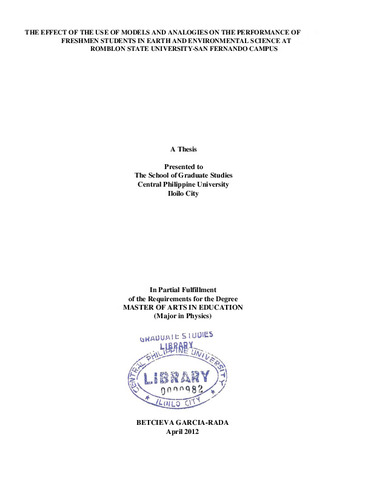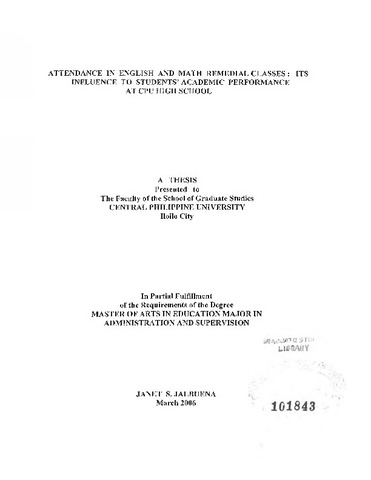Показать сокращенную информацию
The relative effectiveness of two methods of teaching science in grade six
| dc.contributor.adviser | Griño, Eliza U. | |
| dc.contributor.author | Goboy, Manuel M. | |
| dc.date.accessioned | 2021-02-18T00:41:13Z | |
| dc.date.available | 2021-02-18T00:41:13Z | |
| dc.date.issued | 1972 | |
| dc.identifier.citation | Goboy, M. M. (1972). The relative effectiveness of two methods of teaching science in grade six (Unpublished Master's thesis). Central Philippine University, Jaro, Iloilo City. | en_US |
| dc.identifier.uri | https://hdl.handle.net/20.500.12852/454 | |
| dc.description | Abstract only | en_US |
| dc.description.abstract | It was the purpose of this study to find out which of the two methods, the Traditional Method (Method One) or the Process Approach (Method Two), is more effective in teaching grade six science as revealed by the scores on a final academic achievement test. The experiment was conducted in Guisijan Elementary School, District of Laua-an, Division of Antique, and the subjects used were grade six pupils matched on the basis of sex, age, mental ability and science background. There were sixty-two pupils involved. Each group was made up of thirteen boys and eighteen girls. In order to test the equatedness of the two groups in the four factors previously mentioned, the mean difference between the two groups, in age and in composite score, were tested for significance with the use of the critical ratio. The difference between the standard deviations of the two groups was also tested for significance in order to determine the variability and the homogeneity of the two groups. Method One (Traditional Method) was used with Group One, and Method Two (Process Approach), with Group Two. The experiment covered two units of study. The usual unit test was given after teaching each unit. The daily subject matter was made identical for both groups. The subject matter was taken from the Science Curriculum Guide in Grade Six, issued by the Bureau of Public Schools. Common tests were administered to both groups, one at the end of every unit teaching. A final achievement test was given at the culmination of the experiment. All the tests were analyzed for validity and reliability. The same textbook and references were used for both groups when a need for reading arose. The same teacher (the experimenter himself) taught both classes. Provisions were made to make the classroom situations in both classes similar. The results from the two unit tests and the final achievement test showed that Group Two consistently got higher means than Group One. For the first unit test, the obtained critical ratio was 3.41. This was significant at the .05 level. For the second unit test, the obtained critical ratio was 3.88. This is significant at the .05 level. The results from the final achievement test obtained a critical ratio of 3.81, which was highly significant, even beyond the .01 level. The difference between the standard deviations of the two groups in the final achievement test obtained the critical ratio of 2.14, a figure significant at the .05 level. The final achievement test, then revealed that Group Two which had a greater standard deviation, became more variable than Group One. As to the development of the four types of abilities: (1) ability to recall facts; (2) ability to classify information and data including quantitative results, or to interpret classified data; (3) ability to apply previous knowledge and understanding; and (4) ability to make generalizations and conclusions, the results show that Group One had a higher mean than Group Two, but the difference between the means was not significant at the .05 level. The data obtained on the other three showed that Group Two consistently had a higher mean than Group One. The Process Approach used with Group Two is, therefore, a better method in developing these abilities. Prom the results of a substudy, it was found out that the boys and girls showed no difference in achievement. Conclusions From this study, it can be said that: 1. The Process Approach could be considered a better method in teaching grade six science. It was decidedly better in the development of (1) the ability to classify information and data, (2) the ability to apply previous knowledge and understanding, and (3) the ability to make generalizations and conclusions; and just as good as the Traditional Method for the development of the ability to recall facts. 2. The Process Approach allowed the brighter pupils to achieve or learn more than the Traditional Method, as shown by a significant difference in variability with Group Two obtaining more higher scores. 3. The boys and girls who were matched in age, mental ability, and science background learned as much science as each other. | en_US |
| dc.format.extent | xv, 219 leaves | en_US |
| dc.language.iso | en | en_US |
| dc.subject.ddc | GSL Theses 378.242 G538 | en_US |
| dc.subject.lcsh | Science--Study and teaching (Elementary) | en_US |
| dc.subject.lcsh | Teaching | en_US |
| dc.subject.lcsh | Effective teaching | en_US |
| dc.subject.lcsh | Effective teaching--Evaluation | en_US |
| dc.subject.lcsh | Philippines--Antique | en_US |
| dc.title | The relative effectiveness of two methods of teaching science in grade six | en_US |
| dc.type | Thesis | en_US |
| dc.description.bibliographicalreferences | Includes bibliographical references | en_US |
| dc.contributor.chair | Griño, Eliza U. | |
| dc.contributor.committeemember | Espada, Wilfredo G. | |
| dc.contributor.committeemember | Porter, Josefina Y. | |
| dc.contributor.committeemember | Ruiz, Macario | |
| dc.contributor.department | School of Graduate Studies | en_US |
| dc.description.degree | Master of Arts in Educaton | en_US |
| local.subject | Guisijan Elementary School | en_US |
| local.relation.associatedcontent | https://repository.cpu.edu.ph/handle/20.500.12852/2075 Journal article published in Southeast Asia Journal | en |





